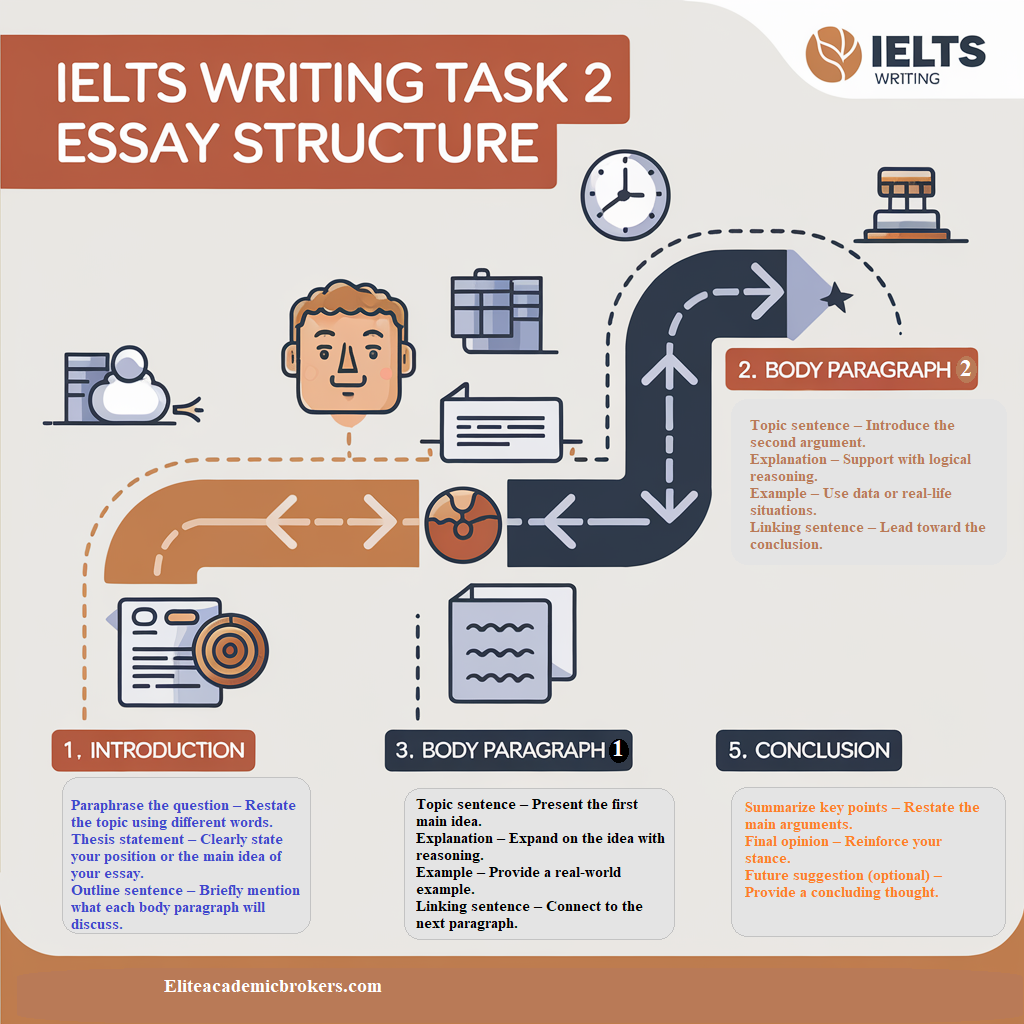Understanding the essay structure is essential to prepare for the IELTS Writing Task 2. A good task 2 essay structure improves readability and enhances your score by demonstrating clarity, coherence, and logical progression of ideas. This guide will walk you through the optimal IELTS essay structure to maximize your chances of achieving a high band score.

Understanding the IELTS Writing Task 2 Essay Structure
The IELTS Writing Task 2 requires candidates to write a 250-word essay within 40 minutes, per the official IELTS guidelines (British Council, 2024). Different types of essays exist, including opinion, discussion, advantage/disadvantage, and problem/solution essays. However, a universal structure remains effective across all types.
Introduction (40-50 words)
The introduction should present the topic and outline your response. It consists of:
- Paraphrased Question: Restate the essay question in your own words.
- Thesis Statement: Clearly state your opinion or main argument.
- Outline Sentence: Briefly mention what your body paragraphs will discuss.
Example:
Topic: Some people believe that technology has made life easier, while others argue that it has increased stress. Discuss both views and give your opinion.
Introduction: “Technology has significantly transformed human lives, bringing both conveniences and challenges. While some argue that technological advancements simplify daily tasks, others contend that they lead to greater stress. This essay will discuss both perspectives before presenting my viewpoint that technology’s benefits outweigh its drawbacks.”
Why is this important? A strong thesis statement is crucial as it provides direction for the essay and ensures coherence a key criterion in IELTS band descriptors (IELTS Band Descriptors, 2024).
2. Body Paragraph 1 (80-100 words)
- Topic Sentence: Present the first main idea.
- Explanation: Elaborate on the idea.
- Example: Provide a real-world example or evidence to support your claim.
- Linking Sentence: Connect to the next paragraph.
Read on IELTS Essay Writing
Example:
“On one hand, technology has made life more efficient by automating tasks. For instance, online banking and digital communication have reduced the time and effort required for transactions and interactions. A report by McKinsey & Company (2023) found that automation increases productivity by 30%, allowing individuals to focus on essential activities.”
Tip: Strong examples from reputable sources enhance credibility. Always provide evidence rather than generic statements.
3. Body Paragraph 2 (80-100 words)
- Topic Sentence: Introduce the second argument.
- Explanation: Provide reasoning and justification.
- Example: Support with evidence or an example.
- Linking Sentence: Leads towards the conclusion.
Example:
“On the other hand, technology has also increased stress levels due to constant connectivity. Social media notifications, work emails, and online responsibilities create pressure and disrupt work-life balance. A study by the University of California (2023) found that 70% of employees feel overwhelmed by digital distractions, highlighting the challenges of constant connectivity (Smith et al., 2023).”
Always contrast both perspectives to showcase critical thinking a skill valued in IELTS writing.
4. Conclusion (40-50 words)
- Summarize Key Points: Restate the main arguments.
- Final Opinion: Reinforce your stance.
- Future Implication/Suggestion: Optionally, provide a concluding thought.
Example:
“In conclusion, while technology enhances convenience and efficiency, it also contributes to stress through digital overload. However, by using technology wisely and maintaining a balanced approach, individuals can reap its benefits without experiencing negative effects. Future advancements should focus on improving digital well-being.”
Why does this work? A strong conclusion ties the essay together and leaves a lasting impression, reinforcing your argument effectively.
Tips for High Band Score
Use Linking Words: Ensure smooth transitions (e.g., moreover, in contrast, consequently).
Maintain a Formal Tone: Avoid contractions (e.g., use ‘do not’ instead of ‘don’t’).
Check Grammar & Spelling: Grammatical accuracy is crucial for a high score.
Stay Within Word Limit: Aim for 250-280 words to avoid penalties.
Enhance Vocabulary: Use precise and varied vocabulary (e.g., instead of ‘good,’ use ‘beneficial’ or ‘advantageous’).
Practice with Official Prompts: Regularly write essays using real IELTS questions (Cambridge IELTS Books).
Practice Task
Try writing an introduction for the following IELTS Task 2 question using the structure above:
Question: Some people believe public transportation should be free for all citizens. Do you agree or disagree?
Challenge: Apply the paraphrasing, thesis statement, and outline sentence techniques discussed in this guide.
Following this structure and refining your writing skills can significantly enhance your IELTS essay performance and help you achieve a higher band score. According to the IELTS scoring criteria,
coherence, cohesion, and lexical resources are key factors contributing to a strong essay (
British Council, 2024).
Final Thoughts
By incorporating structured writing, strong examples, and well-supported arguments, you increase your chances of scoring Band 7+. Consistent practice and expert-backed strategies are the keys to success!
Sources & References
- British Council. (2024). IELTS Writing Band Descriptors. Retrieved from https://www.ielts.org
- Cambridge University Press. (2024). Official IELTS Practice Materials.
- McKinsey & Company. (2023). The Impact of Automation on Productivity.
- University of California. (2023). The Digital Distraction Dilemma.









 Evan John
Evan John